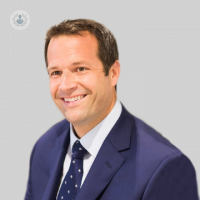Ask an expert: Top 5 knee surgeries
Written in association with:Persistent knee pain and associated mobility problems are often a barrier to an active lifestyle. Understandably, many patients with chronic knee issues look to surgery to provide relief, whether their problem was caused by an injury or as a consequence of a condition such as arthritis. More than one hundred thousand knee replacements are performed across the UK every year, making knee surgery amongst the most common types of surgical procedure patients undergo. In this informative article, leading orthopaedic surgeon Mr Christopher Bailey gives fascinating insight into the most common surgical procedures he performs to treat knee complaints.

1. Arthroscopy
Arthroscopy is a very common procedure as it has many applications. It is a minimally invasive (key-hole) type of surgery which uses a slim tube to insert a very small camera inside the knee itself. This is done under general anaesthetic.
A key advantage of this type of procedure is that the camera allows the surgeon to actually see the joint up close from within, meaning the surgeon can diagnose or treat the problem very effectively. Additionally, because this type of surgery uses very small instruments, only tiny incisions are required which lowers risks of infections and other complications, as well as shortening recovery time.
This type of procedure is used to treat many types of knee complaints, including meniscal tears and also for ligament reconstructions.
2. ACL Reconstruction
The tearing of the anterior cruciate ligament (ACL), a tough band of tissue that crosses the centre of the knee joint, is often the painful result of a sporting accident. This typically happens when the foot is planted firmly but sudden, strong pressure causes the knee to twist and the ligament to tear. The reconstruction procedure uses a graft, usually from the hamstring or the patellar tendon, to repair the tear in the ligament with screws and a suspension device.
3. MPFL Reconstruction
The medial patellofemoral ligament (MPFL) is found near to the ACL. It links the inner part of the kneecap to the thighbone and can sometimes become stretched or overly slack after damage to the knee or an injury occurs. This slackness can mean that the kneecap dislocates more easily than usual and so often requires surgery.
In an MPFL reconstruction, a synthetic polyester tape is used to strengthen the ligament’s hold of the kneecap.
4. Total knee replacement
Damage to the knees from arthritis can leave patients with chronic pain and a loss of mobility. Given that arthritis is a relatively common condition, total knee replacements are being increasingly used to improve patients’ quality of life.
In a total knee replacement, the damaged surface of the knee joint is replaced so that it can move smoothly again. This procedure is increasingly being performed using robotic arm assistance.
5. Partial knee replacement
In some patients, arthritic damage only affects part of the knee joint and therefore a total knee replacement may not be necessary. A partial knee replacement, also known as a unicondylar or unicompartmental replacement, replaces only the damaged part of the knee.
A specially made component is implanted and the other parts of the knee are left intact, making it a smaller scale surgery with a speedier recovery time compared with a full replacement.
If you are considering knee replacement surgery or are looking for treatment for an ACL or MPFL tear, you can book a consultation with Mr Bailey by visiting his Top Doctors profile.


